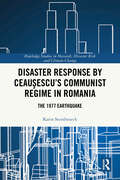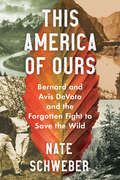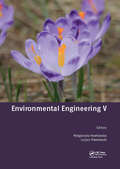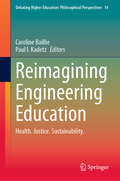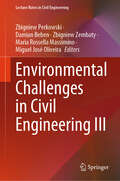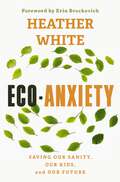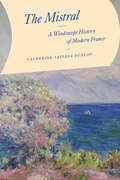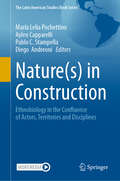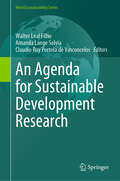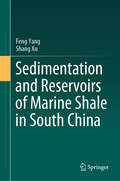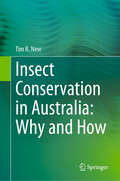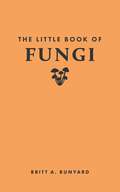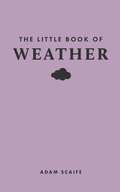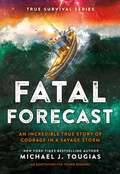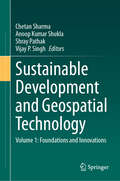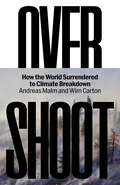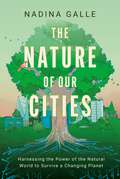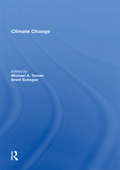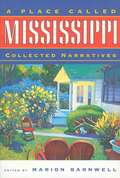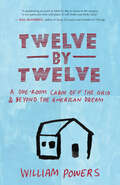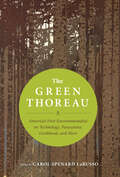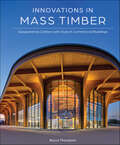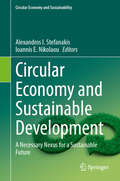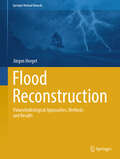- Table View
- List View
Disaster Response by Ceauşescu’s Communist Regime in Romania: The 1977 Earthquake (Routledge Studies in Hazards, Disaster Risk and Climate Change)
by Karin SteinbrueckThis book contains the first comprehensive history using extensive primary sources to trace the 1977 earthquake disaster response by the Ceauşescu communist regime, contextualizing its contribution to the public risk that remains in Romania's capital Bucharest. It traces a history of one authoritarian government’s disaster response linking its decisions and ultimate inactions to contemporary public risk. The book begins with a stand-alone chapter to introduce readers to twentieth-century Communist Romania and contextualize the Ceauşescu regime’s response. It provides insights into how Radio Free Europe filled the information vacuum, how the political police, the Securitate, worked as first responders, and how scientific experts debated the best course of action. It examines how the regime requested specific foreign assistance and activated its Securitate abroad to encourage such, prioritized restoration of the economy, and "encouraged" domestic cash and labor contributions in the name of recovery. The book examines how the disaster response abruptly ended, leaving thousands of structurally unsafe buildings. It explains the contemporary seismic risk and post-communist mitigation efforts to reduce it.This book will be of interest to students, researchers, and policy-makers in the fields of history, disaster studies, urban planning, politics, and those interested in communist-era Romania, Europe, and Eurasia; totalitarian and authoritarian regimes.
This America of Ours: Bernard and Avis DeVoto and the Forgotten Fight to Save the Wild
by Nate SchweberWinner of the High Plains Book Award | Best Book of the Year - Outdoor Writers Association of America“A brilliant rendering of what 'the open space of democracy' must be if we are to survive its present state of erosion.” –Terry Tempest Williams The untold and “energetic” history of the extraordinary couple who rescued national parks from McCarthyism—and inspired a future of conservation (Wall Street Journal)In late-1940s America, few writers commanded attention like Bernard DeVoto. Alongside his brilliant wife and editor, Avis, DeVoto was a firebrand of American liberty, free speech, and perhaps our greatest national treasure: public lands. But when a corrupt band of lawmakers, led by Senator Pat McCarran, sought to quietly cede millions of acres of national parks and other western lands to logging, mining, and private industry, the DeVotos entered the fight of their lives. Bernard and Avis built a broad grassroots coalition to sound the alarm—from Julia and Paul Child to Ansel Adams, Arthur Schlesinger Jr., Alfred Knopf, Adlai Stevenson, and Wallace Stegner—while the very pillars of American democracy, embodied in free and public access to Western lands, hung in the balance. Their dramatic crusade would earn them censorship and blacklisting by Joe McCarthy, J. Edgar Hoover, and Roy Cohn, and it even cost Bernard his life.In This America of Ours, award-winning journalist Nate Schweber uncovers the forgotten story of a progressive alliance that altered the course of twentieth-century history and saved American wilderness—and our country’s most fundamental ideals—from ruin.
Environmental Engineering V
by Lucjan Pawłowski Małgorzata PawłowskaPoland, like other post-communist countries, is undergoing a transformation into a capitalist system. This transformation affects the country in many ways: economic, social, psychological and also ecological. Ecological problems are strongly connected with the political, economic and psychological inheritance of the past, as well as with changes in the post-communist society. In order to understand these problems, it is necessary to consider the following issues:- the geographic situation of Poland - the political transformations that occurred after World War II – forced development of heavy industry combined with neglect of its effects on the environment, and - the economic problemsThe three main goals of Environmental Engineering V are (I) to assess the state of scientific research in various areas of environmental engineering. (II) to evaluate organizational, technical and technological progress in contributing to ecological security, and (III) to determine the place of environmental engineering in sustainable development, taking into account political and economic conditions. Environmental Engineering V is of interest for academics, engineers and professionals involved in environmental engineering, seeking solutions for environmental problems in emerging new democracies, especially those who plan to participate in numerous projects sponsored by the European Union.
Reimagining Engineering Education: Health. Justice. Sustainability. (Debating Higher Education: Philosophical Perspectives #14)
by Caroline Baillie Paul I. KadetzThis book considers a radical change to engineering education. It argues for a reexamination of the traditional way in which engineering students are educated in disciplinary silos and how, instead, we might re-imagine their professional education to more appropriately prepare students to design innovative solutions to increasingly complex global challenges. It poses the question: “How can engineers think outside the engineers’ box?". A box that has over generations rendered engineers to be unquestioning servants of the socio-political systems in which they function. The book introduces a unique framework and language for engineering education which considers both the problems of the past and present, and the potential solutions offered for the future. By reaching out beyond the bounds of traditional knowledge and thought collectives, this book will also offer a pathway for other professional education programs to explore.
Environmental Challenges in Civil Engineering III (Lecture Notes in Civil Engineering #615)
by Zbigniew Zembaty Damian Beben Zbigniew Perkowski Maria Rossella Massimino Miguel José OliveiraThis book gathers a selection of papers presented at the 6th International Scientific Conference “Environmental Challenges in Civil Engineering”, ECCE 2024, held on April 22–24, 2024, in Opole, Poland. Written by an international group of experts, it reports on findings concerning structural material behavior, and new methods and technologies in constructions. A special emphasis is given to sustainable constructions practices, including material recycling and reuse, renovation and restoration of historical building and to those fostering sustainable development of cities and rural areas, and a better integration of buildings with the environment. Offering a good balance of theory and practice, and covering both technical and organizational aspects in civil engineering and architectural projects, this book offers extensive information on solutions and current challenges in construction projects and structural interventions in the context of environmental protection, earthquake prevention and sustainable urban planning.
Eco-Anxiety: Saving Our Sanity, Our Kids, and Our Future
by Heather WhiteThe climate crisis and its resulting eco-anxiety is the biggest challenge of our time. The anxiety that comes with worrying about how environmental harm will impact our--and our children's--lives can be overwhelming. Learn how to balance practicing daily sustainability actions while caring for your own eco-anxiety in this revolutionary book from noted environmentalist Heather White.In Eco-Anxiety, White shows you how to contribute to the climate movement through self-discovery and self-care. Utilizing the Service Superpower Profile Assessment included in the text, you&’ll discover how your personality, interests, and strengths can be of service to others and the planet. This book will serve as your guide to:Begin a 21-Day Kickstarter Plan that shares specific sustainable actions you can takeTrack your progress with journal prompts and exercises that'll help you measure mental health benefitsListen and talk with loved ones about their climate anxietyCommit to being an eco-aware individual and inspire your family, friends, and community to work toward a regenerative, sustainable worldSetting the intention each day to take a small step to care for the planet--can help ease your eco-anxiety, push the culture toward climate solutions, and create a sense of joy.One Green Thing>
The Mistral: A Windswept History of Modern France
by Catherine Tatiana DunlopAn in-depth look at the hidden power of the mistral wind and its effect on modern French history. Every year, the chilly mistral wind blows through the Rhône valley of southern France, across the Camargue wetlands, and into the Mediterranean Sea. Most forceful when winter turns to spring, the wind knocks over trees, sweeps trains off their tracks, and destroys crops. Yet the mistral turns the sky clear and blue, as it often appears in depictions of Provence. The legendary wind is central to the area’s regional identity and has inspired artists and writers near and far for centuries. This force of nature is the focus of Catherine Dunlop’s The Mistral, a wonderfully written examination of the power of the mistral wind, and in particular, the ways it challenged central tenets of nineteenth-century European society: order, mastery, and predictability. As Dunlop shows, while the modernizing state sought liberation from environmental realities through scientific advances, land modification, and other technological solutions, the wind blew on, literally crushing attempts at control, and becoming increasingly integral to regional feelings of place and community.
Nature: Ethnobiology in the Confluence of Actors, Territories and Disciplines (The Latin American Studies Book Series)
by María Lelia Pochettino Aylen Capparelli Pablo C. Stampella Diego AndreoniThis book provides the state of the art of ethnobiology in Argentina and related Latin American countries, highlighting timely trends and topics. It synthesizes studies resulting from the III Jornadas Argentinas de Etnobiología y Sociedad (III JAES—3rd Argentinian Meeting of Ethnobiology and Society), convened in La Plata in 2021. As a relatively new academic development, ethnobiology integrates approaches from different points of view, such as biology, anthropology, geography, history, linguistics, and, in a crucial recent advance, local perspectives. Consequently, this volume contains 33 contributions from 86 authors of different countries, orientations, and disciplines—but all related to interrelationships between people/s and the natural environment. Chapters cover a diverse array of topics, ranging from biocultural relationships and their historical construction through time to conservation of biocultural and agrodiversity, ethnomycology, ethnophycology, and meliponiculture and beyond. The volume’s main goal is to propitiate the preservation of biocultural diversity through the application of ethnobiological wisdom in a global context characterized by the accelerated loss of traditional knowledge. The contributions aim to transcend the nature/culture dichotomy, emphasizing the inextricable relationship between communities and their environment and the importance of acting jointly in the construction of the inhabited landscape and local identity.
An Agenda for Sustainable Development Research (World Sustainability Series)
by Walter Leal Filho Amanda Lange Salvia Claudio Ruy Portela de VasconcelosThis book involves establishing a set of priorities and a roadmap that can guide scholarly and practical efforts towards sustainability goals. It encourages collaboration across disciplines to address complex sustainability issues that span social, economic, and environmental domains. It also supports the development of robust methodologies for conducting research, including quantitative, qualitative, and mixed methods approaches. But despite the importance of and the need for an agenda for sustainable development research, many efforts are isolated and thematically disconnected. Also, it is difficult to find information on how sustainability research is being undertaken and on the wide range of methods being used. Against this backdrop and in order to facilitate a broad discussion on the contribution of sustainable development research, this book is being produced. The book gathers inputs from universities and research organisations working on matters related to sustainable development research in a variety of contexts. It also provides a platform for the dissemination of information on the latest initiatives, paving the way for technology transfer and networking. Furthermore, the book intends to provide a fertile basis upon which universities, research centres, and practitioners may cooperate more closely in this key area. Last but not least, a further aim of the book is to present methodological approaches and experiences deriving from case studies and projects, which aim to show how sustainability research may be implementing across a range of disciplines. Thanks to its scope and interdisciplinarity, this books makes an excellent reading to everyone interested on sustainability research.
Sedimentation and Reservoirs of Marine Shale in South China
by Feng Yang Shang XuThis book systematically investigates the depositional process and reservoir characteristics of organic-rich shales, including (1) The types and development mechanisms of organic-rich shales under ancient ocean and climatic backgrounds. Schematic models are proposed to understand the organic matter enrichment and depletion in shale systems. (2) Microstructure and petrophysical properties. The general lithofacies are recognized and linked to the depositional setting and petrophysical properties. Full-scale pores and fractures are characterized using FE-SEM, gas adsorption, nano-CT and micro-CT scanning. (3) Brittle-ductile characteristics. Rock mechanical properties and in-situ stress are determined. The brittle-ductile transformation of shales is discussed. (4) Shale gas occurrence state and differential enrichment. Gas content and dynamic dissipation over geological time are evaluated using sorption experiments and numerical simulation. Shale gas enrichment model is developed to understand the gas differential accumulation in organic-rich shales. This book can be used for reference by researchers engaged in shale oil and gas geology in both academics and industry.
Insect Conservation in Australia: Why and How
by Tim R. NewThe fundamental ecological, cultural and economic roles of insects give them central importance in functioning of terrestrial and inland water ecosystems worldwide. Insect declines, from a variety of anthropogenic threats, erode these services and dictate the need for insect conservation, but the consequences of insect losses are poorly recognised. In Australia, insect conservation must proceed from a very uncertain and incomplete knowledge of insect identifications and diversity, and also from a generally poor public appreciation of their central ecological roles and relevance to human welfare and other biota. These impediments occupy much of this book, in which cases of insect conservation across the world are used to provide lessons for Australia, where a combination of large numbers of insect species and small numbers of entomologists and citizen participants necessitates clear appreciation of insect importance, and focussed conservation priorities. Low public sympathy and inadequate scientific information can hinder progress because uncertainty, imprecision and ignorance are difficult to explain to policymakers and funding agencies whose interest and support may be pivotal. Understanding and overcoming those impediments is a vital component of insect conservation. This book is intended as an introduction to the needs, rationale and practice of insect conservation in Australia for students in conservation biology, managers and other concerned people who are not specialists in entomology, to whom the daunting variety and complexity of insect life may deter involvement, and for whom an Appendix aid to recognising insect orders is included. The text is based on conservation needs of Australia’s insects and shows how progress necessitates effective communication, clear priorities, and plans for action within a realistic and practical framework of aims and needs for practical conservation. A suggested ‘Agenda’ for advancing insect conservation in Australia encompasses many of these needs and activities.
The Little Book of Fungi (Little Books of Nature)
by Britt A. BunyardA charming, richly illustrated, pocket-size exploration of the world&’s fungiPacked with surprising facts, this delightful and gorgeously designed book will beguile any nature lover. Expertly written and beautifully illustrated throughout with color photographs and original color artwork, The Little Book of Fungi is an accessible and enjoyable mini-reference about the world&’s fungi, with examples drawn from across the globe. It fits an astonishing amount of information in a small package, covering a wide range of topics—from morphology, diversity, and reproduction to habitat and conservation. It also includes curious facts and a section on fungi in myths, folklore, and modern culture from around the world. The result is an irresistible guide to the amazing lives of fungi.A beautifully designed pocket-size book with a foil-stamped cloth coverFeatures some 140 color illustrations and photosMakes a perfect gift
The Little Book of Weather (Little Books of Nature)
by Adam ScaifeA charming, richly illustrated, pocket-size exploration of the world&’s weatherPacked with surprising facts, this delightful and gorgeously designed book will beguile anyone who is curious about weather. Expertly written and beautifully illustrated throughout with color photographs and original color artwork, The Little Book of Weather is an accessible and enjoyable mini-reference about the world&’s weather, with examples drawn from across the globe. It fits an astonishing amount of information in a small package, covering a wide range of topics—from weather forecasting and extreme events such as hurricanes and typhoons to the future of weather with climate change. It also includes curious facts, myths, and history—from whether animals can predict the weather to the bad weather that helped doom Napoleon and Hitler&’s invasions of Russia and the Soviet Union. The result is an irresistible guide to the amazing world of weather.A beautifully designed pocket-size book with a foil-stamped cloth coverFeatures some 140 color illustrations and photosMakes a perfect gift
Fatal Forecast: An Incredible True Story of Courage In a Savage Storm (True Survival Series #2)
by Michael J. TougiasAs harrowing as The Perfect Storm—but with a miraculous ending—Fatal Forecast is one of the greatest survival stories ever told—now available as a young readers edition.★ "Plunges into the action with pulse-pounding panache…. Readers will be rooting for all these courageous men in this thrilling, edge-of-your-seat survival tale." —Booklist, starred review On the morning of November 21, 1980, two small boats set out from Cape Cod for Georges Bank, a prosperous fishing ground one hundred miles out to sea. The National Weather Service had forecast typical fall weather, and the young crew aboard the Sea Fever and the Fair Wind had no reason to expect that this trip would be any different from the dozens they&’d made earlier in the season. What they didn&’t know was that the only weather buoy in the area was malfunctioning as the National Weather Service had failed to reveal this critical data. As the two boats headed out, a colossal storm was brewing, a furious maelstrom that would batter the boats with sixty-foot waves and hurricane-force winds. This true story of catastrophe and survival at sea is a vivid moment-by-moment account of seventy-two hours in the lives of eight men. Most amazing is the story of Ernie Hazard, who spent more than fifty terrifying hours in—and out of—a tiny life raft, careening in the monstrous waves. Gripping and heart-pounding, this page-turning young readers edition is an unforgettable story about the collision of two spectacular forces: the brutality of nature and the human will to survive. An adaptation for young readers of Fatal Forecast: An Incredible True Tale of Disaster and Survival at Sea."Middle and early high school readers who love a gripping adventure or survival story will tear through this one. Highly recommended." —School Library Journal
Sustainable Development and Geospatial Technology: Volume 1: Foundations and Innovations
by Vijay P. Singh Chetan Sharma Anoop Kumar Shukla Shray PathakThis two-volume set showcases the various ways in which geospatial technology can be used to achieve sustainable development goals across different sectors such as urban planning, natural resource management, agriculture, disaster management, and energy management. The books provide insights into the potential of geospatial technology in promoting sustainable development practices and addressing challenges related to climate change, environmental degradation, and socio-economic development. Both volumes together are a comprehensive guide that showcases the potential of geospatial technology in promoting sustainable development practices across different sectors, and will serve as an essential resource for professionals, policymakers, researchers, and students interested in sustainable development and geospatial technology. Volume 1 introduces the intertwined realms of sustainable development and geospatial technology. It navigates readers through the fundamental principles of sustainable development, exploring its goals and the pivotal role geospatial technology plays in its realization. Beginning with an overview of these critical concepts, it subsequently dives into the core foundations of geospatial technology, covering Geographic Information Systems (GIS), remote sensing, spatial data analysis, and data visualization. The volume also encompasses the practical aspects of sustainable urban planning, natural resource management, and transportation planning using GIS, underpinning the relevance of geospatial technology in addressing contemporary global challenges.
Overshoot: How the World Surrendered to Climate Breakdown
by Andreas Malm Wim CartonA scathing critique of proposals to geoengineer our way out of climate disaster by the bestselling author of How to Blow Up a PipelineIt might soon be far too hot on this planet. What do we do then? In the era of "overshoot," schemes abound for turning down the heat–not now, but a few decades down the road. We&’re being told that we can return to liveable temperatures by means of technologies for removing CO2 from the air or blocking incoming sunlight.If they even exist, such technologies are not safe.They come with immense uncertainties and risks. Worse, like magical promises of future redemption, they might provide reasons for continuing to emit in the present. But do they also hold some potentials? In Overshoot two leading climate scholars subject the plans for saving the planet after it&’s been wrecked to critical study. Carbon dioxide removal is already having effects, as an excuse for continuing business as usual, while geoengineering promises to bail out humanity if the heat reaches critical levels.Both distract from the one urgent task: to slash emissions now. There can be no further delay. The climate revolution is long overdue, and in the end, no technology can absolve us of its tasks.
The Nature of Our Cities: Harnessing the Power of the Natural World to Survive a Changing Planet
by Nadina GalleIn the tradition of Elizabeth Kolbert and Michael Pollan, The Nature of Our Cities is a stirring exploration of how innovators from around the world are combining urban nature with emerging technologies, protecting the planet’s cities from the effects of climate change and safeguarding the health of their inhabitants.We live in an age when humanity spends 90% of its time indoors, yet the nature around us—especially in America’s cities—has never been more vital. This distancing from nature has sparked crises in mental health, longevity, and hope for the next generation, while also heightening the risks we face from historic floods, heatwaves, and wildfires. Indeed, embracing nature holds untapped potential to strengthen and fortify our cities, suburbs, and towns, providing solutions spanning flood preparation, wildfire management, and promoting longevity. As ecological engineer Dr. Nadina Galle shows in The Nature of Our Cities nature is our most critical infrastructure for tackling the climate crisis. It just needs a little help. A fellow at MIT’s Senseable City Lab and selected for Forbes’ 30 under 30 list, Galle is at the forefront of the growing movement to fuse nature and technology for urban resilience. In THE NATURE OF OUR CITIES, she embarks on a journey as fascinating as it is pressing, showing how scientists and citizens from around the world are harnessing emerging technologies to unlock the power of the natural world to save their cities, a phenomenon she calls the “Internet of Nature.” Traveling the globe, Galle examines how urban nature, long an afterthought for many, actually points the way toward a more sustainable future. She reveals how technology can help nature navigate this precarious moment with modern advances such as:Laser-mapping that identifies at-risk neighborhoods to fight deadly health disparitiesA.I.-powered robots that prevent wildfires from reaching urban areasIntelligent water gardens that protect cities from floods and hurricanesAdvanced sensors that achieve 99% tree survival in dry, hot summers Optimistic in spirit yet pragmatic in approach, Galle writes persuasively that the future of urban life depends on balancing the natural world with the technology that can help sustain it. By turns clear-eyed and lyrical, THE NATURE OF OUR CITIES marks the emergence of an invigorating, prescient new talent in nature writing.
Climate Change
by Michael A. TomanOver the years, a large and growing literature on the economics of climate change has developed. Within this volume the contributors have included a wide range of journal essays that consider the impact of climate change on specific sectors; goods and services; the costs and benefits of greenhouse gas (GHG) mitigation; and policy design for mitigation, including both domestic instruments and issues related to international agreements.
A Place Called Mississippi
by David G. SansingFilled with serendipitous connections and contrasts, this volume of Mississippiana covers four hundred years. It begins with a selection from “A Gentleman from Elvas,” written in 1541, and ends with an essay the novelist Ellen Douglas wrote in 1996 on the occasion of the Atlanta Olympic games. In between is a chronology of some one hundred nonfictional narratives that portray the distinctiveness of life in Mississippi. Most are reprinted, but some are published here for the first time. Each section of this anthology reveals an aspect of Mississippi’s past or present. Here are narratives that depict the settlement of the land by pioneers, the lasting heritage of the Civil War, the pleasures and the pastimes of Mississippians, their food, art, rituals, and religion, the terrain and the travelers, and the conflicts that brought enormous changes to both the landscape and the population. In its wide cultural perspective, A Place Called Mississippi includes an early description of the Chickasaws, a narrative of a former slave, “Soggy” Sweat’s famous “Whiskey Speech” on Prohibition, and an account of how W. C. Handy discovered the blues in a deserted train station in Tutwiler, Mississippi. Among the selections are narratives by Jefferson Davis, Belle Kearney, Walter Anderson, Ida B. Wells, Richard Wright, Craig Claiborne, Richard Ford, William Faulkner, and Eudora Welty. Written by and about blacks, whites, Native Americans, and others, these fascinating accounts convey a variety of impressions about a real place and about real people whose colorful history is large, ever-changing, and ever-mystifying.Filled with serendipitous connections and contrasts, this volume of Mississippiana covers four hundred years. It begins with a selection from “A Gentleman from Elvas,” written in 1541, and ends with an essay the novelist Ellen Douglas wrote in 1996 on the occasion of the Atlanta Olympic games. In between is a chronology of some one hundred nonfictional narratives that portray the distinctiveness of life in Mississippi. Most are reprinted, but some are published here for the first time. Each section of this anthology reveals an aspect of Mississippi’s past or present. Here are narratives that depict the settlement of the land by pioneers, the lasting heritage of the Civil War, the pleasures and the pastimes of Mississippians, their food, art, rituals, and religion, the terrain and the travelers, and the conflicts that brought enormous changes to both the landscape and the population. In its wide cultural perspective, A Place Called Mississippi includes an early description of the Chickasaws, a narrative of a former slave, “Soggy” Sweat’s famous “Whiskey Speech” on Prohibition, and an account of how W. C. Handy discovered the blues in a deserted train station in Tutwiler, Mississippi. Among the selections are narratives by Jefferson Davis, Belle Kearney, Walter Anderson, Ida B. Wells, Richard Wright, Craig Claiborne, Richard Ford, William Faulkner, and Eudora Welty. Written by and about blacks, whites, Native Americans, and others, these fascinating accounts convey a variety of impressions about a real place and about real people whose colorful history is large, ever-changing, and ever-mystifying.
Twelve by Twelve: A One-Room Cabin Off the Grid and Beyond the American Dream
by Bill PowersWhy would a successful American physician choose to live in a twelve-foot-by-twelve-foot cabin without running water or electricity? To find out, writer and activist William Powers visited Dr. Jackie Benton in rural North Carolina. No Name Creek gurgled through Benton’s permaculture farm, and she stroked honeybees’ wings as she shared her wildcrafter philosophy of living on a planet in crisis. Powers, just back from a decade of international aid work, then accepted Benton’s offer to stay at the cabin for a season while she traveled. There, he befriended her eclectic neighbors — organic farmers, biofuel brewers, eco-developers — and discovered a sustainable but imperiled way of life. In these pages, Powers not only explores this small patch of community but draws on his international experiences with other pockets of resistance. This engrossing tale of Powers’s struggle for a meaningful life with a smaller footprint proposes a paradigm shift to an elusive “Soft World” with clues to personal happiness and global healing.
The Green Thoreau: America's First Environmentalist on Technology, Possessions, Livelihood, and More
by Henry David ThoreauHenry David Thoreau saw nature as teacher and companion, and many of his philosophies guide the contemporary environmental movement. What Thoreau wrote about simplicity, materialism, technology, and our troubled relationship with nature is perhaps even more relevant to our lives today than it was in the nineteenth century. In these pages, editor Carol Spenard LaRusso presents quotations by Thoreau on nature, technology, livelihood, living, possessions, time, diet and food, and aspiration. At turns passionate, funny, and profound, this collection serves as a compelling introduction — or vivid reminder — of why Thoreau is one of America’s iconoclastic greats.
Innovations in Mass Timber: Sequestering Carbon with Style in Commercial Buildings
by Boyce ThompsonTrending topic on which there are few books, none written from a purely design point of view. Wooden Buildings Reach for the Skyhttps://www.nytimes.com/2021/07/30/todaysinyt/wooden-buildings-reach-for-the-sky-in-vaxjo-sweden.html?referringSource=articleShareFive Stories Tall and Made of Woodhttps://www.nytimes.com/2020/01/17/realestate/five-stories-tall-and-made-of-wood.html?referringSource=articleShareAs Concerns Over Climate Change Rise, More Developers Turn to Woodhttps://www.nytimes.com/2020/09/22/business/mass-timber-wood-buildings.html?referringSource=artichttps://www.nytimes.com/2019/11/20/style/engineered-wood-tower-construction.html?.?mc=aud_dev&ad-keywords=auddevgate&gclid=Cj0KCQjwg7KJBhDyARIsAHrAXaHHY8errrxRyekMa3u1yfaO3-hlB6P4tpWt23X1l9NnbkdQxH2J8z8aAtAcEALw_wcB&gclsrc=aw.ds
Proceedings of the 5th International Conference on Transportation Geotechnics: Sustainable Infrastructure and Numerical Modeling in Roads, Rails, and Harbours (Lecture Notes in Civil Engineering #408)
by Buddhima Indraratna Cholachat Rujikiatkamjorn Jianfeng XueThis book presents select proceedings of the 5th International Conference on Transportation Geotechnics (ICTG 2024). It includes papers on ground improvement methodologies, dynamics of transportation infrastructure, and geotechnical intricacies of mega projects. It covers topics such as underground transportation systems and heights of airfields and pavements. This book discusses diverse thematic landscapes, offering profound explorations into sensor technologies, data analytics, and machine learning applications. The publication highlights advanced practices, latest developments, and efforts to foster collaboration, innovation, and sustainable solutions for transportation infrastructure worldwide. The book can be a valuable reference for researchers and professionals interested in transportation geotechnics.
Circular Economy and Sustainable Development: A Necessary Nexus for a Sustainable Future (Circular Economy and Sustainability)
by Alexandros I. Stefanakis Ioannis E. NikolaouThis book will highlight the role of CE in the sustainability field as it is expressed in the various fields and disciplines and its contribution to building a sustainable society by providing a better understanding of the relevant social and cultural structures and the need for cross-disciplinary knowledge and diverse skills. Such an integrated approach which combines the concept of sustainability in the engineering field to create a CE, has not yet been presented in detail in the published literature, and there are only scattered studies covering only small parts of this holistic approach. Hence, this book will represent a single reference that will provide summarized information and state-of-the-art knowledge on this topic of the future. The book will include chapters showcasing/investigating the relation between circular economy principles and their realization in different engineering fields. This includes theoretical justification, research studies and full-scale case studies. The approach focuses on two distinct levels: macro and micro, on both production and consumption sides.
Flood Reconstruction: Palaeohydrological Approaches, Methods and Results (Springer Natural Hazards)
by Jürgen HergetFloods are among the most common and consequential natural disasters on Earth, occurring in all natural areas at all times. Yet, they often surprise us with their unexpected magnitude and the damage they cause. Terms like century and millennium floods quickly become widespread, but what do we really know about the floods of the past? How can we truly classify events like the Mississippi flood of 1993, the Elbe flood of 2002, or the Pakistan flood of 2010? Have such floods occurred before, or are they unprecedented, perhaps even consequences of ongoing climate change? To answer these questions, we must look into the past. However, river level records are often limited in duration, rarely extending back more than a hundred years, and many regions lack any measured values at all. Nonetheless, floods have left their marks. These marks may exist in the form of historical records and descriptions, which vary in extent across different cultural contexts. In addition to historical records, natural indicators like deposited sediments or erosion traces provide valuable information about past flood levels. This is particularly important for prehistoric periods and for regions without dense settlements and related gauges. These investigations lead to further questions about maximum flood levels and the earliest recorded observations. This book addresses these questions by exploring the reconstruction of floods from both historical and prehistoric times. It explains and discusses methods and results for beginners with diverse backgrounds in disciplines such as earth sciences, hydrology, history, and engineering. Extensive and carefully selected reference lists offer access to additional information.
